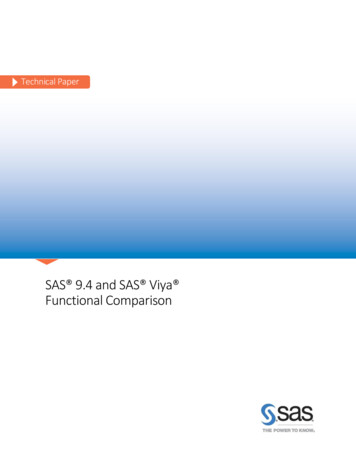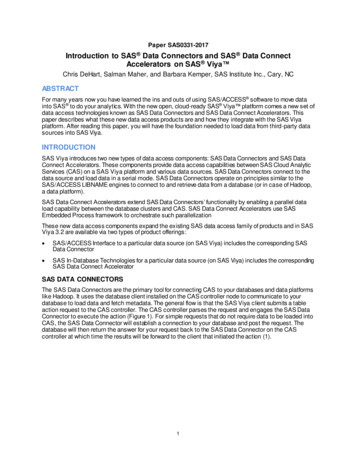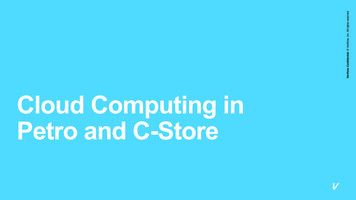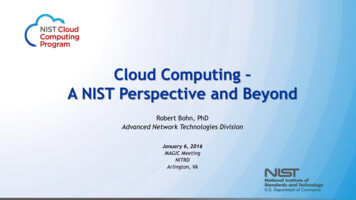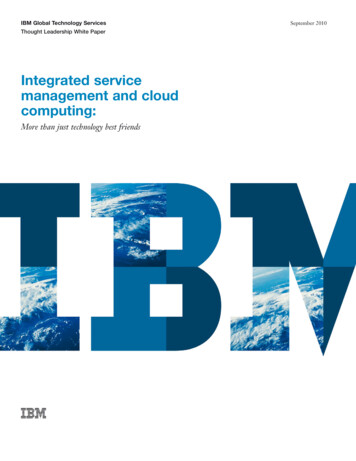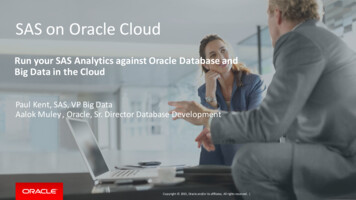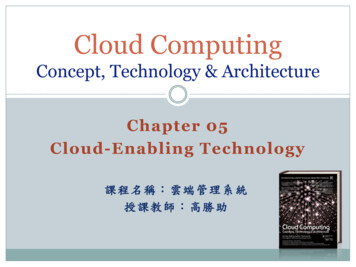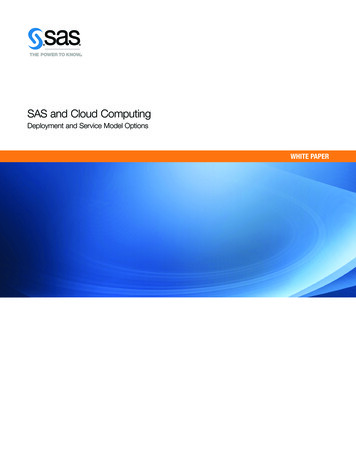
Transcription
SAS and Cloud ComputingDeployment and Service Model OptionsWHITE PAPER
SAS White PaperTable of ContentsExecutive Summary. . . . . . . . . . . . . . . . . . . . . . . . . . . . . . . . . . . . . . . . . 1Cloud Computing Service and Deployment Models . . . . . . . . . . . . . . 2Cloud Computing Characteristics . . . . . . . . . . . . . . . . . . . . . . . . . . . . . 2Standard Service Models . . . . . . . . . . . . . . . . . . . . . . . . . . . . . . . . . . . 3Standard Deployment Models . . . . . . . . . . . . . . . . . . . . . . . . . . . . . . . 4Virtualization: A Key Enabler for Cloud Computing. . . . . . . . . . . . . . . 4SAS Cloud Deployment Options and Offerings . . . . . . . . . . . . . . . . . 5SAS Cloud . . . . . . . . . . . . . . . . . . . . . . . . . . . . . . . . . . . . . . . . . . . . . . 5SAS Cloud Tools and Technologies. . . . . . . . . . . . . . . . . . . . . . . . . . . 5Public Cloud Infrastructure with SAS on Amazon . . . . . . . . . . . . . . . . 6The Private Cloud with SAS Grid Manager . . . . . . . . . . . . . . . . . . . . . 6Cloud Computing with SAS Solutions OnDemand . . . . . . . . . . . . . . . 8Feeling Secure with SAS Solutions OnDemand for YourCloud Environment. . . . . . . . . . . . . . . . . . . . . . . . . . . . . . . . . . . . . . . . . 9Security and compliance . . . . . . . . . . . . . . . . . . . . . . . . . . . . . . . . . . . . . . . . . . 9Practices, policies and capabilities of SAS Solutions OnDemand . . . . . . . . . . 10Case Studies . . . . . . . . . . . . . . . . . . . . . . . . . . . . . . . . . . . . . . . . . . . . . 10ISO: Private Cloud with SAS Grid Manager . . . . . . . . . . . . . . . . . . . 10McKesson: Winning Big with SAS Solutions OnDemand . . . . . . . . . 11Enterprise Hosting with SAS: North Carolina Office of the StateController Is Getting Tougher with Crime . . . . . . . . . . . . . . . . . . . . . . 12SAS: Internal Private Cloud with PaaS Deployment . . . . . . . . . . . . . . 13Conclusion: SAS as Your Cloud Partner . . . . . . . . . . . . . . . . . . . . . . 15
SAS and Cloud ComputingExecutive SummaryToday’s economic climate – with rising customer expectations, an accelerated businesspace and fierce competition – requires organizations to make better use of their everincreasing volumes of data for fact-based decision making. More and more enterprisesare taking their data use to new levels and applying business analytics to supportrigorous, constant business experimentation that drives better decisions – whether itinvolves testing new products, developing better business models or transforming thecustomer experience. The challenge to provide more and better information faster ischanging the traditional approach to information technology.Cloud computing’s ability to provide elastic scalability, faster service delivery, greaterIT efficiencies and a subscription-based accounting model has broken down manyof the physical and financial barriers to aligning IT with evolving business goals. Withits promise to deliver better business models and services quickly and cheaply, cloudcomputing has become a major driver of business innovation across all industries, andthe market adoption of cloud services is delivering increasing revenue to cloud servicesproviders. According to Gartner Inc. in its 2012 Forecast Overview: Public CloudServices, Worldwide 2011-2016, the worldwide public cloud services market size in2011 was 93 billion, and it is projected to grow to 211.9 billion in 2016.1 211.9billion 93billion20112016Figure 1: Growth and forecast of the worldwide public cloud services market.While this paper discusses SAS Cloud, and tools and technologies that deliverand support SAS in cloud environments, traditional on-premises SAS deploymentswill remain a key strategy for many of our customers. SAS Cloud is not a change indirection, but rather an effort to make SAS available to a broader audience throughexpanded deployment and delivery options.This paper discusses the convergence of SAS software with the corporate movementto cloud computing. With clear goals to continue delivering business analytics softwareto enable fact-based decisions, SAS is committed to providing our customers withdeployment options that target their evolving IT and business requirements. Thisincludes enabling SAS Business Analytics for cloud deployment.1Gartner Inc. 2012 Forecast Overview: Public Cloud Services, Worldwide, 2011-2016, 3Q12 Update.November 2012.1
SAS White PaperIn addition, this paper provides a summary of terms and concepts within the paradigmof cloud computing and “as-a-service” delivery models, focusing on different optionsand what SAS offers. Because virtualization enables the creation of flexible cloudswith elastic computing resources, this paper presents a high-level overview of thattechnology. Other elements needed for successful cloud computing, such as security,data management, scalability and policy-based compliancy, are also addressed.After reading this overview, we hope you will work with SAS to plan a cloud strategythat is best suited for your organization.Cloud Computing Service and Deployment ModelsIt is helpful to frame the discussion of cloud computing within the market taxonomy.We start with the definitions of the cloud established by the National Institute ofStandards and Technology (NIST),2 which are adopted broadly by the technologyanalyst community and consumer marketplace.capabilities we willprovideCHARACTERISTICS capabilities we willdeliverOn-Demand Self ServiceBroad Network AccessMeasured ServiceResource PoolingRapid ElasticitySERVICE MODELScapabilities to be runhere Software as a Service(SaaS) Platform as a Service(PaaS) Infrastructure as a Service(IaaS)DEPLOYMENTMODELS Private CloudPublic CloudHybrid CloudCommunity CloudFigure 2: The key characteristics, service models and deployment models of cloudcomputing, according to the NIST.Cloud Computing CharacteristicsCloud computing fundamentally changes the way IT services are delivered andconsumed. Many perspectives define the benefits and characteristics of cloudcomputing, including business flexibility, operational efficiency and economies of ITand scale.The NIST definition of cloud computing highlights the business value delivered throughSAS Cloud Services offerings: Self-service access to get the software up and running quickly. Easy access from a diverse set of locations, devices and environments. Flexible options that build on capacity-based, user-based and value-based pricing. Resource sharing that is cost-efficient and sustainable for IT providers withoutcompromising user capabilities. Options that scale as needed.22nist.gov
SAS and Cloud ComputingStandard Service ModelsIn addition, NIST defines three standard service models: Software as a service (SaaS). SaaS enables consumers to use applicationsrunning on a cloud infrastructure. The applications can be accessed from variousclient devices through a thin-client interface such as a Web browser (for example,from Web-based email). The user does not manage or control the underlying cloudinfrastructure or individual application capabilities, with the possible exception oflimited user-specific application configuration settings. Platform as a service (PaaS). PaaS enables users to deploy their created oracquired applications using programming languages, frameworks and tools thatare provided by the supplier. The consumer does not manage or control theunderlying cloud infrastructure (networks, servers, operating systems and storage),but does have control over deployed applications and possibly the applicationhosting configurations. Infrastructure as a service (IaaS). IaaS is considered the most basic “as-aservice” level where infrastructure equipment and resources are provided to clients.These can include storage, networks, processing and other general computingresources. The IaaS user is able to run software, has control over operatingsystems, applications and frameworks, and performs the general administrativefunctions, but does not manage or control the underlying infrastructure.SAS Cloud tools and technologies include select offerings of SAS Business Analyticsthrough software as a service (SaaS). SAS Cloud also includes a cloud developmentplatform as a service (PaaS). As a software provider, SAS is not focused on providingthe third model, infrastructure as a service ctsCompanyConfidential -(IaaS)For Internal providesUse OnlyFigure 3: Infrastructureasa servicecloud infrastructure that is typicallyCopyright 2013, SAS Institute Inc. All rights reserved.accessed by IT and operations. IaaS delivers cloud infrastructure support for software asa service (SaaS) and platform as a service (PaaS). PaaS can provide development andrun-time support for SaaS, but it is not required because SaaS can be delivered on topof IaaS.3
SAS White PaperStandard Deployment ModelsFour standard deployment models are reflected in the industry: public cloud, privatecloud, hybrid cloud and community cloud. To provide flexibility that meets the demandsof our customers, SAS software can be deployed in on-premises private clouds, in aprivate cloud environment hosted by SAS and in commercially available public cloudenvironments such as Amazon EC2. SAS also supports the combination of public andprivate clouds in hybrid cloud deployment configurations. Private cloud. SAS customers seeking to benefit from cloud computing whilemaintaining control over their environment might choose a private cloud. Whetheryour goal is to more efficiently use existing underutilized hardware, simplify IToperations or provide users with scalable, on-demand access to applications, SASprovides multiple options for making SAS software available through private clouddeployment. Private clouds can be built and managed within an enterprise datacenter, or can be hosted by a third-party provider and managed either on- or offpremises. SAS cloud-enabled tools and solutions can be deployed and managedin private clouds. And, SAS Grid Manager can be used to build and manage yourown private SAS cloud. SAS also provides enterprise-managed private cloudhosting through SAS Solutions OnDemand. Public cloud. Public clouds are open to the general public with cloudinfrastructures that are owned and managed by the cloud service provider.Customers can benefit from cloud infrastructure cost efficiencies by deploying SASon a public cloud infrastructure such as Amazon. SAS also provides professionalservices to assist customers who need advice setting up their SAS environment ina public cloud. Hybrid cloud. Customers can choose to create a bridge between public andprivate clouds to address increased demand for computing resources – such asend of month needs or peak shopping seasons. SAS Cloud Services supportsscaling of deployments to meet fluctuating levels of demand. Community cloud. Sometimes several organizations with similar requirementsmay seek to share infrastructure to realize common goals. They will discover thata community cloud facilitates the necessary collaboration. While it is a widelyaccepted practice within the field of academia, commercial and governmentalorganizations are slowly augmenting their IT strategies with community clouddeployments. In the case of commercial organizations, the use and resources ofa neutral third party best supports the common mission, security requirements,and policy and compliance considerations of multiple organizations.Virtualization: A Key Enabler for Cloud ComputingVirtualization is a core technology that enables the cloud computing model. In thispaper, we focus on the virtualization of physical machines (i.e., the abstraction of logicalresources away from their underlying physical resources). Using virtual machines (versusphysical machines) as building blocks improves agility and flexibility.4
SAS and Cloud ComputingFor IT, virtualization technology reduces the costs of physical resources through thetechnologies’ ability to host multiple virtual machines on a single physical machine. IT isable to provide a more highly available infrastructure by using server clustering throughvirtualization. This allows IT to more easily manage failover and redirect users to availableservers when a server fails, and provide load balancing to redirect users to underutilizedinfrastructure for improved system response times.Private cloud environments are built on virtualization so underutilized hardware cansupport multiple logical machines that are consolidated into a smaller number of betterutilized devices.SAS Cloud Deployment Options and OfferingsSAS CloudThe SAS Cloud is a hosted private cloud environment where customers can subscribeto SAS Cloud tools and technologies to receive rapid, self-service access to SAS Cloudanalytics tools and solutions. Through service packages offered by SAS, customers areable to have SAS assist them with preparing and moving their data to the SAS Cloud.Following initial data preparation and movement, additional data can be added in thefuture through bulk uploads or trickled uploads.The SAS Cloud benefits customers by providing quick user access without customershaving to acquire hardware. In addition, SAS performs all hardware and softwaremanagement and maintenance and guarantees that the most current version of SASsoftware is running at all times.SAS Cloud Tools and TechnologiesSAS 9.4 includes architecture updates that enable SAS Business Analytics to be rapidlyand easily deployed and managed in cloud environments. SAS Cloud Services toolsand technologies include: SAS Virtual Applications (SAS vApps). These prepackaged, multiple-systemvirtual appliances are designed for easy and rapid deployment in cloudenvironments. SAS vApps contain one or more virtual machines that make up theapplication environment. Also included in each vApp is a ledger that is read bythe deployment service to instruct how to unpack the vApp and how each virtualmachine in the vApp is to be unpacked and configured. SAS Visual Analytics isthe first SAS solution to be offered through this new subscriber service. SAS App Central. Role-based, Web portal interface enables providers,administrators and users to manage and access SAS software in cloudenvironments.»» Administrators acquire and maintain SAS vApps and manage SAS user access.»» Subscribers log in and access the SAS tools and solutions they have beengiven access to. They can also request access to new SAS tools and solutions.5
SAS White Paper SAS App Engine. These technologies are used to assemble and deploy SASvApps and maintain deployed SAS vApp environments.»» A distributed environment facilitates the delivery and updates of SAS vAppimages. SAS Administrators access the SAS App Engine through SASApp Central.»» The SAS App Engine can check SAS servers to validate that theenvironments have not been modified since the last update and to monitorfor configuration creep. SAS App Works. This SAS cloud platform supports agile development andpromotes sharing and collaboration between development teams. SASprogrammers can work together with business analysts, data scientists and Webdevelopers to build custom applications that integrate SAS into their businessprocesses and create interactive custom reports and dashboards for users.SAS Cloud tools and technologies can be deployed and used in private and public cloudenvironments. While all SAS tools and solutions are not available as SAS vApps, a rollingschedule of SAS vApp offerings is being made available.Public Cloud Infrastructure with SAS on AmazonAs an approach to reduce the total cost of IT operations and allow IT to focus on corebusiness objectives, many companies are turning to public cloud infrastructures. Takingadvantage of cloud usage-based pricing is often desirable, but public cloud providersalso provide an infrastructure that is highly available, scalable and easy to manage.Starting with SAS 9.3 M2, SAS customers can deploy SAS on Amazon Web ServicesElastic Compute Cloud (AWS EC2). While AWS EC2 is supported as a deploymentenvironment for SAS, it is recommended that customers use AWS Virtual Private Cloud,which provides increased isolation, control, customization and security through a virtualprivate cloud environment within Amazon’s public cloud infrastructure.Different from SAS vApp deployment and management, with this approach SAStools and solutions are installed on Amazon infrastructure using the same process ason-premises deployment of SAS. However, there are configuration and integrationdifferences between traditional on-premises deployment of SAS and Amazondeployment of SAS. If needed, SAS Professional Services can assist customers withdeploying SAS on Amazon.The Private Cloud with SAS Grid ManagerWorking with the expectation that an IT organization desires tight controls overservice levels and infrastructure or has concerns over data privacy and security,many enterprises will opt for a private cloud deployment where applications remainon-site. Compliance concerns surrounding shared technology become a moot pointwith a private cloud. With this option, IT builds the private cloud, which is used onlyby its enterprise.6
SAS and Cloud ComputingTo enable private cloud computing for its customers, SAS has partnered with PlatformComputing to offer SAS Grid Manager. SAS Grid Manager allows users to submit SASjobs to a shared and highly available pool of resources (rather than to an individualserver) to balance workloads, decrease processing times and better manage their SASenvironment. Computing-intensive programs can be allocated and managed to run inpieces across the grid, enabling IT organizations to optimize hardware capacity, improveperformance and offer more flexibility.SAS Grid Manager provides the ability to scale business processes and acceleratedecisions, giving organizations a significant competitive advantage. Deploying SASproducts and solutions with SAS Grid Manager to run in a private cloud centralizesmanagement and reduces the complexity of your SAS environment, creates a highlyavailable environment to allow business continuity, enhances performance of ITresources and increases flexibility to scale out and meet fluctuating demands.The key capabilities offered by SAS Grid Manager include enterprise job scheduling,workload balancing and the ability to segment large jobs and run the segments inparallel using a virtual pool of resources in a distributed environment. Enterprise job scheduling allows you to create and schedule SAS workflows overmultiple distributed machines. SAS Grid Manager will automatically find and selectthe best available resource to execute each job within that flow. Workload balancing is essential for optimizing the workloads of multiple userssubmitting multiple types of jobs to a shared pool of resources. SAS Grid Managerprovides queuing of jobs, policies for different types of workloads to deliver thedesired service levels, and prioritization of workloads to meet the needs of differentbusiness units as well as the entire organization. Large SAS applications or programs can be broken into segments that can be runin parallel using SAS Grid Manager. Huge performance gains can be realized whenyou have workloads that can be broken into independent subtasks and run acrossdistributed resources in a grid environment.When considering SAS
SAS vApps contain one or more virtual machines that make up the application environment . Also included in each vApp is a ledger that is read by the deployment service to instruct how to unpack the vApp and how each virtual machine in the vApp is to be unpacked and configured . SAS Visual Analytics is

